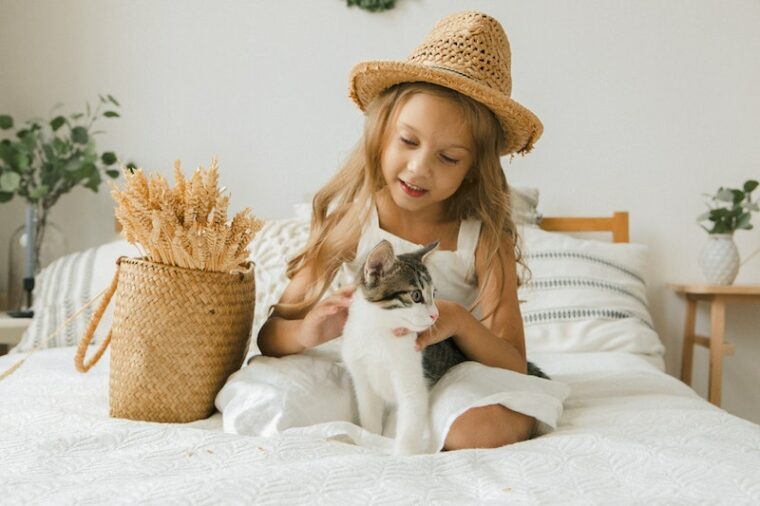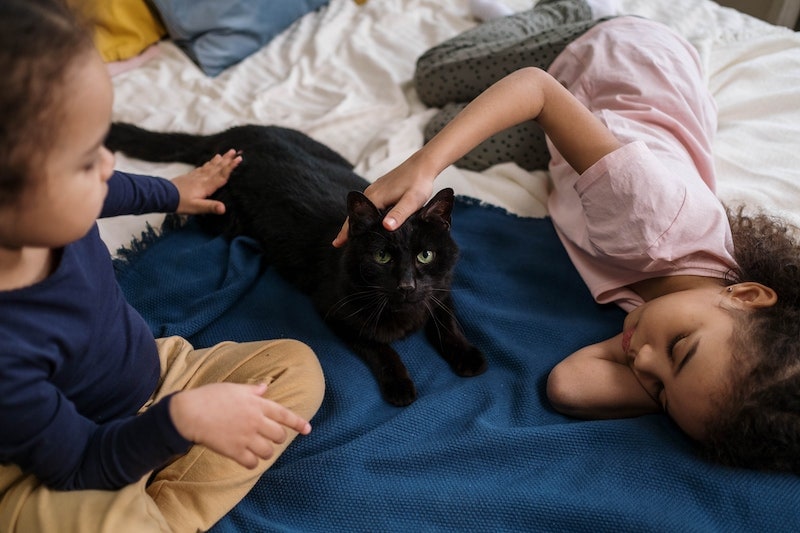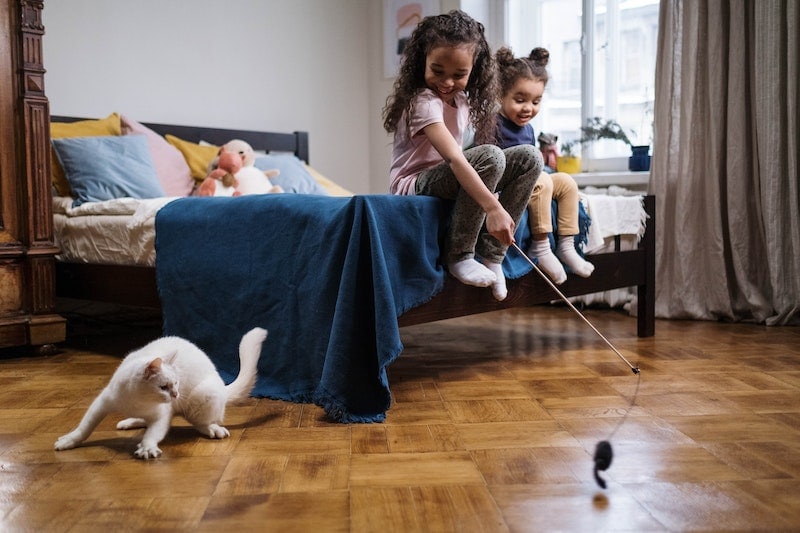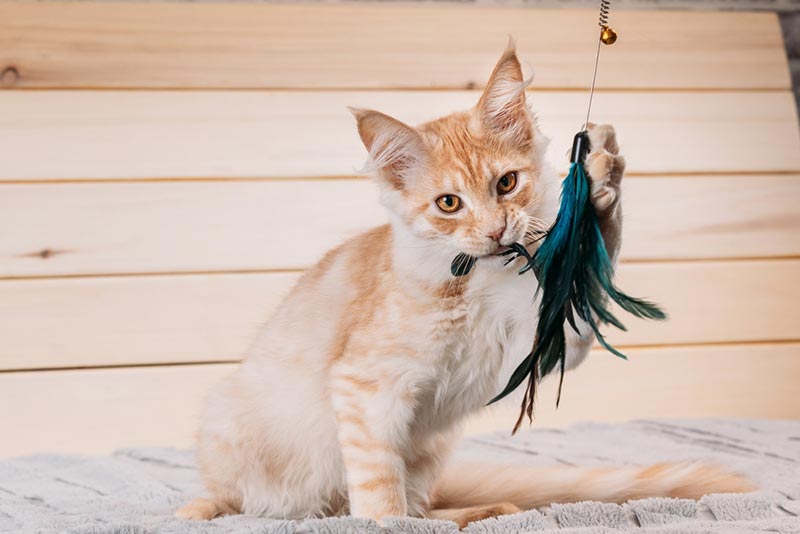
Cats are wonderful pets that often become beloved family members. While they have the potential to become excellent companions, they’re not always the best fit for young children. A general recommendation is to wait until your child is at least 5 years old before bringing a cat home.
It may seem like a good idea to bring home a cat to start teaching a child about responsibility, but it’s often not the best fit for both the child and the cat. So, make sure to consider all the responsibilities of caring for a cat before bringing one home for your child.
The Best Age for Your Child to Get a Cat
Children must be understanding of a cat’s preferences and personality. They have to be at a certain level of maturity to be able to respect a cat’s boundaries and understand its care needs. Therefore, it’s not recommended for families with infants or toddlers to have a cat, especially a young kitten. Children around 5 years old may do well living with an adult cat if they’re able to treat the cat respectfully.
Your child should be able to read a cat’s behavior and know what signs to look for when a cat feels happy, safe, annoyed, and aggressive. Children should also be able to handle and treat a cat gently without requiring repeated reminders.

Things to Consider Before Bringing Home a Cat
While cats are perceived to be more independent pets than dogs, their owners must still take on a significant amount of responsibility to care for a cat. Cats need a lot of exercise and play, especially when they’re younger and have more energy. They must also be fed regularly, and their litter boxes must be kept clean daily.
Not all cats fit into the independent and aloof stereotype. In fact, many cats are social and don’t do well being left home alone for long hours. They may need a lot more attention that young children alone may not be able to give.
Many things go into caring for a cat, and it can be overwhelming to consider each one. So, here are some key factors to think about bringing home a cat.
Cat Breed and Temperament
Different cat breeds have different temperaments. Some are independent, while others are extremely playful. Certain cat breeds are known to be gentle and patient, and other breeds may feel anxious or stressed out by the unpredictability surrounding some children.
Some cat breeds that are known to be good with children are Birmans, Maine Coons, and Ragdolls. Cats that aren’t recommended for young children include Bengals, Persians, Savannahs, and Siamese.
Your Child’s Capacity to Care for a Cat
It’s also important to consider how your child can help care for a cat. Common responsibilities given to young children include helping with feeding and playing with a cat. If your child isn’t able to take on these responsibilities, it’s best to wait until they’re older.
Your Capacity to Care for a Cat
At the end of the day, the responsibility to care for a cat falls on the adult in the family. Caring for a young kitten can often feel like caring for another child, except this child can jump high and climb up to high places. You must be prepared to kitten-proof your home to ensure it doesn’t eat or chew on unsafe food and items.
Cats will also need daily exercise and mental stimulation, which they often receive through interactive play sessions with their owners. You’ll also have to clean out their litter boxes regularly to prevent odors from permeating throughout your house. Dirty litter boxes may also lead to cats urinating outside of them.
You’ll also have to consider grooming and spending extra time cleaning your home so that you don’t have cat hair or cat litter tracks all over your floors and furniture. Some cats also require baths every several weeks.
Because of the extra responsibilities that come with a young kitten, older cats are often recommended for families with young children. Older cats often don’t require as much supervision and attention. So, you’re more likely to feel less stress if you bring home a mature adult cat rather than a kitten or young adult cat.

Preparing Your Child for a New Cat
If your child has demonstrated the ability to live with a cat, you can start to make preparations to bring one home. Make sure to do research on cat breeds to ensure you bring home one that matches your family’s lifestyle. You can also help your child get ready to live with a new pet.
Teach Your Child About Interacting with Cats
Teaching your child about cat behavior and proper interactions with cats can help them both get used to living with each other more quickly. Go over cat behavior and body language cues that cats often express when feeling content, agitated, and anxious.
It’s also important to teach your cat how to treat a cat gently. You can use a stuffed animal to practice how to pet cats and areas to avoid touching, like the face and paws.
Assign and Practice Responsibilities
Children may feel more invested in their cats if they have a designated responsibility. Your child can be responsible for one of the cat’s meals or playing with the cat at a certain part of the day. It’s best not to assign litter box duties to a young child because it can get very messy and unhygienic.
You can help your child feel more excited or prepared for the new cat by practicing these responsibilities. It may also be helpful to take your child with you when you purchase cat supplies. Your child will most likely enjoy picking out certain supplies, like toys, food and water bowls, and cat beds.
Create Plenty of Vertical Spaces
Many cats prefer having vertical spaces where they can retreat for safety. These spaces enable them to rest undisturbed and observe their surroundings from a high vantage point. Vertical spaces are especially necessary for cats living with young children because they can escape to these spots whenever they don’t feel safe or want to be left alone.
Make sure to have a couple of spaces that your cat can reach but your child can’t. It’ll be helpful to establish a rule with your child to leave the cat alone whenever it’s resting in these vertical spaces.

Conclusion
It’s possible for young children and cats to live together harmoniously. However, it’ll depend on the child’s maturity level and ability to take on some cat care responsibilities. So, it’s best to wait until your child is mature enough to respect a cat’s space and consistently follow through on designated responsibilities. Bringing home a breed with a docile and friendly temperament can also help maintain a peaceful dynamic between your child and the cat.
Featured Image Credit: ekaterina bolovtsova, Pexels










